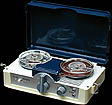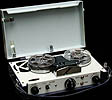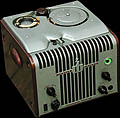| Aiwa TP-30 1965 |
| This is a prototypical 1960s Japanese transistor tape recorder. How fortuitous that the manufacturer's name and model number allows it to appear first in my tape recorder museum display. |  |
| Aiwa TP-60 1965 |
 | "Good morning, Mr. Phelps. Your mission, should you choose to accept it, is to thoroughly appreciate the groovy goodness of this little Aiwa beauty." |
| Aiwa TP-1003 mid-1960s |
 | This is a stereo recorder. It's difficult to imagine why a company would produce a stereo rim-drive recorder, given rim drive's speed-stability limitations which make it unsuitable for music, but here it is. "Let's start making stereo recording of your own today and have a big fun! Are you ready?" |
| Electra 707 "Candid" mid-1960s |
| This is a cute recorder of unusual design. Very tiny, it has a sharp-looking chrome plated top chassis and a removable clear plastic cover. |  |
| Encorder 400 1960s |
 | A small recorder with an all-metal case. Its reels are a mere 1-3/4 inches (45 mm) in diameter. This one was owned at one time by a ham radio operator, as there are some CW (code) QSOs (conversations) recorded on the tape. |
| Mayfair TR-1964 ca. 1964 |
 | Hmm . . . could the 1964 in the model number stand for the year of production? |
| Miny O.M.G.S. 777 1964 |
| Wow! Yet another cute Japanese tape recorder. Pretty blue color. The supply and takeup reels say "Synchrotape TDK Electronics Co., Ltd." Apparently TDK has been around a long time. |  |
| RCA YHS-18J 1966 |
| A tape recorder that's a cut or two above the others on this page. Two-speed capstan drive, five-inch reels, tape counter, seven transistors and a bigger speaker for better sound. Very deluxe. |  |
| Webster-Chicago 81-1 Wire Recorder 1948 |
 | Wire recorders enjoyed a brief heyday from the late 1940s through the early 1950s. Instead of recording by magnetizing waveform patterns on a length of tape coated with iron oxide, wire recorders work by magnetizing patterns on steel wire. The fidelity of the wire recorders I've heard, including this one, is quite good. Despite the good sound, tape recorders won the competitive struggle for consumer acceptance. |
|
|
| Answer ATR-102 ca. 1964 |
| Now, direct from the Answer Manufactory of Tokyo, Japan, is just what you've been waiting for. Yes, it's the incredible Answer ATR-102 Triplecorder! But seriously, this is an unusual rim-drive tape recorder, radio and phonograph combination with an even-more-unusual round shape. |  |
| Concord F-20 ca. 1966 |
| I had one of these as a kid. This model has rim drive, in which a tiny motor drives the edge of the takeup reel turntable. This is a very shaky, unreliable way to supply drive power to the tape, and the resulting tape speed is shaky, too. In an unsuccessful attempt to provide some semblance of audio fidelity, a speed control is provided. |  |
| Concord F-85 mid-1960s |
| This is a deluxe version of the model F-20 above. With its capstan drive, it's in another league as far as speed accuracy and stability is concerned. Why, it's even suitable (in a "lo-fi" way) for reproducing music. |  |
| Crown CTR-550 1960s |
 | This oddly styled (what were they thinking?) recorder's claim to fame is its level/battery meter. I've not seen another cheap rim-drive recorder with one. The meter indicates the audio level in both record and playback, and battery voltage in rewind. |
| Juliette LT-44 ca. 1964 |
 | Another recorder with an all-metal case. The top section is chrome plated. |
| Lloyd's TP-566W ca. 1964 |
 | This is yet another small Mission Impossible type recorder, pictured here before the tape vaporized in a cloud of smoke. This one came from the same factory as the Juliette above. Only "appearance items" are different, like the knobs, and the finish on the case. |
| Star-lite ST-666 "Statesman" 1964 |
 | This is the third version of this design, which came from the same factory as both the Juliette and Lloyds recorders above. |
About the tapes that come with these old recorders
I enjoy old things because they draw me closer to a wonderful bygone era, and as I say on the main page of this Web site, they allow me to "imagine the lives and times of their purchasers and users." Well, these old recorders can take it a big step further. In many cases, I don't have to imagine the original owners, I can hear them, speaking to me.
These old tape recorders almost always come with a reel of tape. This reel is usually the one that came with the recorder when it was new and it has usually been recorded only once. The recordings are often of children, parents, or grandparents.
The fact that the original reel of tape is still present and contains only one recording suggests that these recorders were just novelties. Toys, in fact. Generally unsuitable for recording music, they were used once and then put away and forgotten, only to be found decades later by family members or antique dealers preparing for estate sales. I find the recordings left on the tapes to be both entertaining and poignant.
I had a couple of these toy recorders as a youngster, and although I no longer have the recorders, I have kept the tapes, which are filled with evidence of some playful hours spent talking into a microphone. |
|














